Desmodium
| Desmodium | |
|---|---|
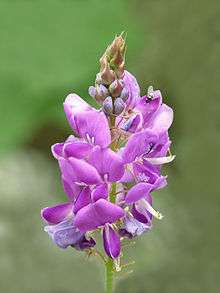 | |
| Desmodium heterocarpon | |
| Scientific classification | |
| Kingdom: | Plantae |
| (unranked): | Angiosperms |
| (unranked): | Eudicots |
| (unranked): | Rosids |
| Order: | Fabales |
| Family: | Fabaceae |
| Subfamily: | Faboideae |
| Tribe: | Desmodieae |
| Subtribe: | Desmodiinae |
| Genus: | Desmodium Desv. |
| Species | |
|
Many, see text | |
| Synonyms | |
|
Catenaria Benth. | |
Desmodium is a genus in the flowering plant family Fabaceae, sometimes called tick-trefoil, tick clover, hitch hikers or beggar lice. There are dozens of species and the delimitation of the genus has shifted much over time.
These are mostly inconspicuous legumes; few have bright or large flowers. Though some can become sizeable plants, most are herbs or small shrubs. Their fruit are loments, meaning each seed is dispersed individually enclosed in its segment. This makes them tenacious plants and some species are considered weeds in places. They have a variety of uses, as well.
Uses
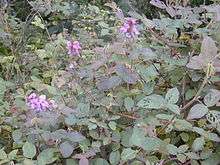
Several Desmodium species contain potent secondary metabolites. They are used aggressively in agriculture in push-pull technology. Tick-trefoils produce high amounts of antixenotic allomones - chemicals which repel many insect pests - and allelopathic compounds which kill weeds. For example, D. intortum and D. uncinatum are employed as groundcover in maize and sorghum fields to repel Chilo partellus, a stem-boring grass moth. They also suppress witchweeds such as Asiatic witchweed (Striga asiatica) and purple witchweed (S. hermonthica).[1]
Tick-trefoils are generally useful as living mulch and as green manure, as they are able to improve soil fertility via nitrogen fixation. Most also make good fodder for animals including bobwhite, turkey, grouse and deer.[1][2][3]
Some Desmodium species have been shown to contain high amounts of tryptamine alkaloids, though many tryptamine-containing Desmodium species have been transferred to other genera.[1]
The caterpillars of the lesser grass blue (Zizina otis) and the two-barred flasher (Astraptes fulgerator) feed on tick-trefoils. Deer also appear to rely on some species in certain areas, particularly during the more stressful summer months.
Use in traditional medicine
Some Desmodium species are used in traditional African medicine, and are also used in Western alternative medicine.
Taxonomy and systematics
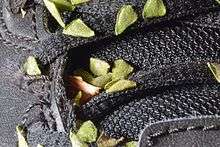
The taxonomy and systematics of the many dozens of Desmodium species are confusing and unresolved. Related genera such as Codariocalyx, Hylodesmum, Lespedeza, Ohwia, and Phyllodium were and sometimes still are included in Desmodium.[4]
Taxonomic authorities commonly disagree about the naming and placement of species. For example, Desmodium spirale as described by August Grisebach might refer to a distinct species, but its validity is doubtful. The "Desmodium spirale" of other authorities may refer to D. neomexicanum, D. ospriostreblum, or D. procumbens. Similarly, the plant originally described as D. podocarpum by A. P. de Candolle is Hylodesmum podocarpum today, but "Desmodium podocarpum" might also refer to D. hookerianum or Hylodesmum laxum, depending on the taxonomic authority.[4]
Selected species[4]
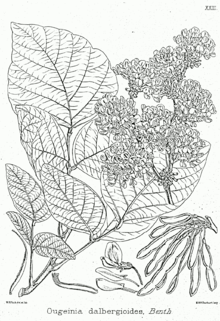
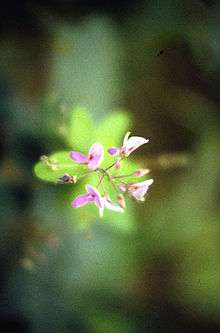
- Desmodium acanthocladum F.Muell.
- Desmodium adscendens DC. - Strongback
- Desmodium canadense – showy tick-trefoil, Canadian tick-trefoil
- Desmodium canescens – hoary tick-trefoil
- Desmodium ciliare (Muhl.) DC. – hairy small-leaved tick-trefoil
- Desmodium concinnum DC.
- Desmodium concinnum var. concinnum (syn. D. penduliflorum Benth.)
- Desmodium cuspidatum (Muhl.) Loudon – toothed tick-trefoil, large-bracted tick-trefoil
- Desmodium dillenii Darl. (sometimes considered a variety of D. paniculatum)
- Desmodium discolor Vog.
- Desmodium elegans DC.
- Desmodium gangeticum
- Desmodium glabellum
- Desmodium glabrum (Mill.) DC. (syn. D. molle (Vahl) DC.)
- Desmodium glutinosum (Willd.) Alph. Wood – pointed-leaved tick-trefoil, large tick-trefoil
- Desmodium heterocarpon (L.) DC.
- Desmodium hookerianum D. Dietr. (syn. D. podocarpum Hook. & Arn.)
- Desmodium humifusum (Muhl. ex Bigelow) Beck
- Desmodium illinoense – Illinois tick-trefoil
- Desmodium incanum – creeping beggarweed, Spanish clover, Spanish tick-trefoil, Kaimi clover, kaʻimi (Hawaiʻi)
- Desmodium intortum – greenleaf desmodium
- Desmodium khasianum (syn. D. oxyphyllum auct. non DC.)
- Desmodium laxiflorum DC. (syn. D. incanum sensu auct.[5])
- Desmodium lineatum (Michx.) DC. – linear-leaved tick-trefoil
- Desmodium marilandicum (L.) DC. – smooth small-leaved tick-trefoil
- Desmodium molliculum (Kunth) DC. – Burbur
- Desmodium nemorosum F.Muell. ex Benth.
- Desmodium neomexicanum (syn. D. bigelovii, D. humile, D. lilloanum, D. parvum, D. spirale auct. non DC. non Griseb. non (Sw.) DC., D. spirale (Sw.) DC. var. bigelovii)
- Desmodium nudiflorum (L.) DC. – bare-stemmed tick-trefoil, naked-flowered tick-trefoil
- Desmodium oojeinense
- Desmodium ospriostreblum (syn. D. spirale DC., D. tortuosum sensu Hepper)
- Desmodium paniculatum (L.) DC. – panicled tick-trefoil
- Desmodium perplexum – perplexed tick-trefoil
- Desmodium procumbens (syn. D. spirale (Sw.) DC., D. sylvaticum, D. tenuiculum)
- Desmodium psilocarpum
- Desmodium ramosissimum G.Don.
- Desmodium rhytidophyllum F.Muell. ex Benth.
- Desmodium rigidum (Ell.) DC. – rigid tick-trefoil
- Desmodium rotundifolium (Michx.) DC. – prostrate tick-trefoil, round-leaved tick-trefoil, dollar leaf
- Desmodium spirale Griseb. (disputed)
- Desmodium tortuosum (Sw.) DC.
- Desmodium triflorum
- Desmodium tweedyi Britton – Tweedy's tick-trefoil
- Desmodium uncinatum – silver-leaved tick-trefoil, silverleaf
- Desmodium varians (Labill.) G.Don
Formerly placed here[4]
- Codariocalyx motorius – telegraph plant (as D. gyrans, D. motorium, D. roylei)
- Hylodesmum laxum (as D. laxum DC.)
 Lespedeza thunbergii was formerly known as Desmodium formosum and Desmodium thunbergii
Lespedeza thunbergii was formerly known as Desmodium formosum and Desmodium thunbergii- Hylodesmum laxum ssp. laxum (as D. austro-japonense, D. bambusetorum, D. gardneri auct. non Benth., D. laxiflorum sensu Miq., D. laxum var. kiusianum, D. laxum ssp. laxum, D. podocarpum auct. non DC. non Hook. & Arn., D. podocarpum DC. var. gardneri sensu Bedd., D. podocarpum DC. var. laxum)
- Hylodesmum leptopus (as D. gardneri Benth., D. laxum auct. non DC., D. laxum ssp. leptopus, D. leptopus, D. tashiroi)
- Hylodesmum podocarpum (as D. podocarpum DC., D. podocarpum DC. var. indicum, D. podocarpum DC. var. japonicum)
- Hylodesmum podocarpum ssp. oxyphyllum (as D. fallax var. mandshuricum, D. japonicum, D. mandshuricum, D. oxyphyllum DC., D. podocarpum DC. var. mandshuricum, D. podocarpum DC. ssp./var. oxyphyllum, D. podocarpum DC. var. polyphyllum, D. podocarpum DC. var. typicum, D. racemosum)
- Lespedeza thunbergii (as D. formosum, D. thunbergii)
- Lespedeza thunbergii var. thunbergii (as D. penduliflorum Oudem.)
- Ohwia caudata (as D. caudatum)
- Phyllodium pulchellum (as D. pulchellum)
- Dendrolobium umbellatum (as D. umbellatum (L.) Benth.
- Dendrolobium triangulare (as D. Desmodium umbellatum Moritz.
and many more
References
- International Legume Database & Information Service (ILDIS) (2005): Genus Desmodium. Version 10.01, November 2005. Retrieved 2007-DEC-17.
- 1 2 3 "The Plant Encyclopedia - Desmodium". The Plant Encyclopedia. Retrieved 17 January 2014.
- ↑ "Plants Profile for Desmodium (ticktrefoil)". plants.usda.gov.
- ↑ "Know Your Deer Plants: Beggar's Lice - Quality Deer Management Association". 25 January 2012.
- 1 2 3 4 ILDIS (2005)
- ↑ See discussion at Desmodium incanum
External links
| Wikimedia Commons has media related to Desmodium. |
| Wikispecies has information related to: Desmodium |
- Trout, K. (2002). Trout’s Notes on the Genus Desmodium. Mydriatic Productions. Better Days Publishing.
